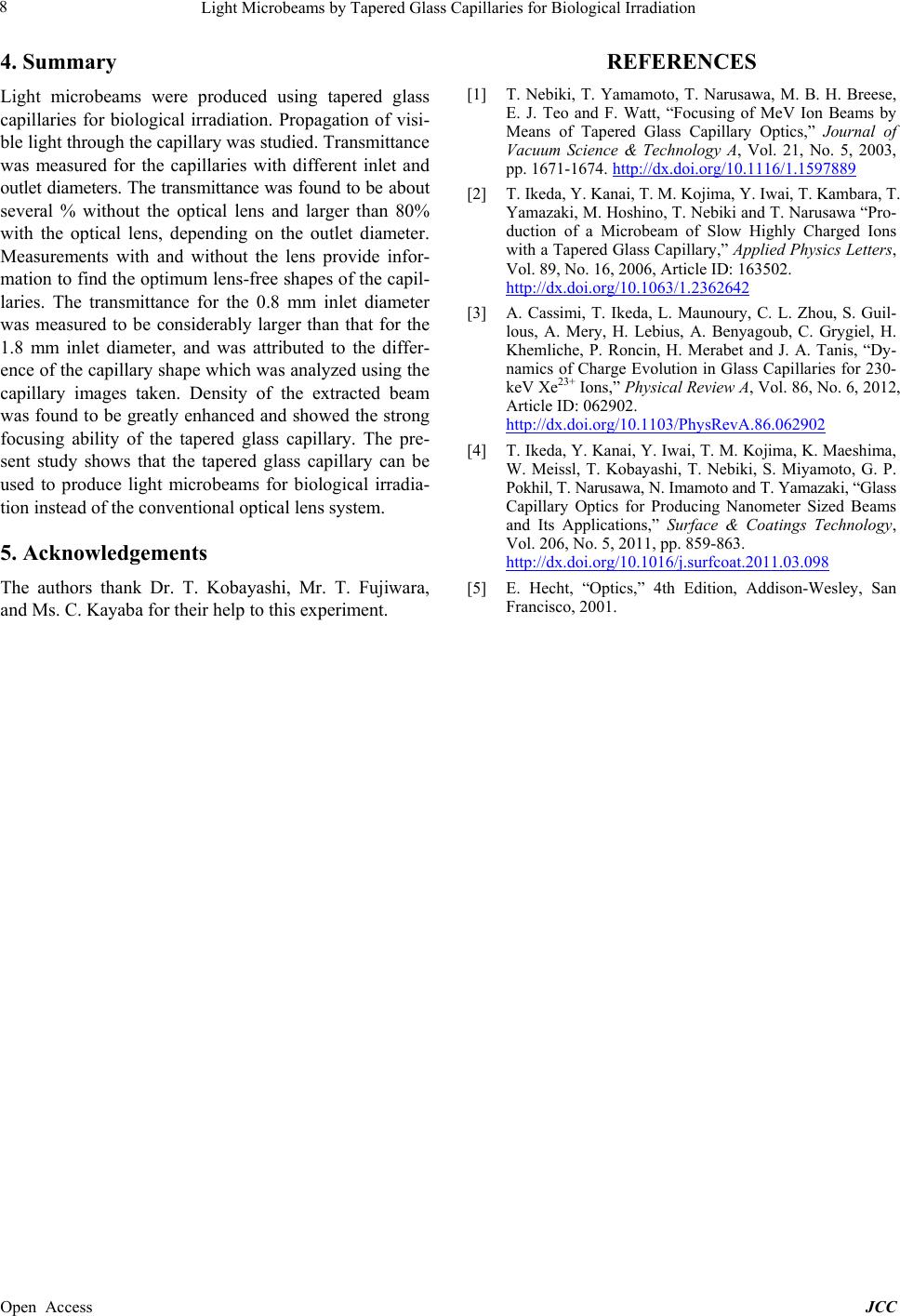
Light Microbeams by Tapered Glass Capillaries for Biological Irradiation
Open Access JCC
4. Summary
Light microbeams were produced using tapered glass
capillaries for biological irradiation. Propagation of visi-
ble light through the capillary was studied. Transmittance
was measured for the capillaries with different inlet and
outlet diameters. The transmittance was found to be about
several % without the optical lens and larger than 80%
with the optical lens, depending on the outlet diameter.
Measurements with and without the lens provide infor-
mation to find the op timum lens-free shapes of the capil-
laries. The transmittance for the 0.8 mm inlet diameter
was measured to be considerably larger than that for the
1.8 mm inlet diameter, and was attributed to the differ-
ence of the capillary shape which was analyzed using the
capillary images taken. Density of the extracted beam
was found to be greatly enhanced and showed the strong
focusing ability of the tapered glass capillary. The pre-
sent study shows that the tapered glass capillary can be
used to produce light microbeams for biological irradia-
tion instead of the conventional optical lens system.
5. Acknowledgements
The authors thank Dr. T. Kobayashi, Mr. T. Fujiwara,
and Ms. C. Kayaba for their help to this experiment.
REFERENCES
[1] T. Nebiki, T. Yamamoto, T. Narusawa, M. B. H. Breese,
E. J. Teo and F. Watt, “Focusing of MeV Ion Beams by
Means of Tapered Glass Capillary Optics,” Journal of
Vacuum Science & Technology A, Vol. 21, No. 5, 2003,
pp. 1671-1674. http://dx.doi.org/10.1116/1.1597889
[2] T. Ikeda, Y. Kanai, T. M. Kojima, Y. Iwai, T. Kambara, T.
Yamazaki, M. Hoshino, T. Nebiki and T. Narusawa “Pro-
duction of a Microbeam of Slow Highly Charged Ions
with a Tapered Glass Capillary,” Applied Physics Letters,
Vol. 89, No. 16, 2006, Article ID: 163502.
http://dx.doi.org/10.1063/1.2362642
[3] A. Cassimi, T. Ikeda, L. Maunoury, C. L. Zhou, S. Guil-
lous, A. Mery, H. Lebius, A. Benyagoub, C. Grygiel, H.
Khemliche, P. Roncin, H. Merabet and J. A. Tanis, “Dy-
namics of Charge Evolution in Glass Capillaries for 230-
keV Xe23+ Ions,” Physical Review A, Vol. 86, No. 6, 2012,
Article ID: 062902.
http://dx.doi.org/10.1103/PhysRevA.86.062902
[4] T. Ikeda, Y. Kanai, Y. Iwai, T. M. Kojima, K. Maeshima,
W. Meissl, T. Kobayashi, T. Nebiki, S. Miyamoto, G. P.
Pokhil, T. Narusawa, N. Imamoto and T. Yamazaki, “Glass
Capillary Optics for Producing Nanometer Sized Beams
and Its Applications,” Surface & Coatings Technology,
Vol. 206, No. 5, 2011, pp. 859-863.
http://dx.doi.org/10.1016/j.surfcoat.2011.03.098
[5] E. Hecht, “Optics,” 4th Edition, Addison-Wesley, San
Francisco, 2001.